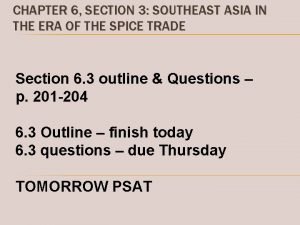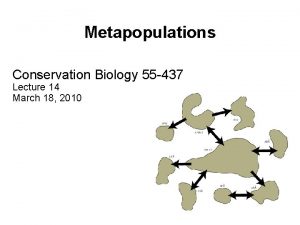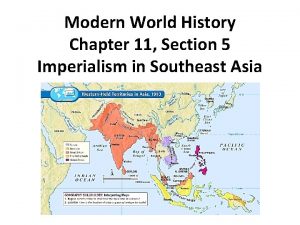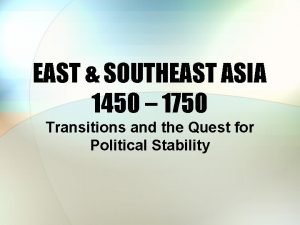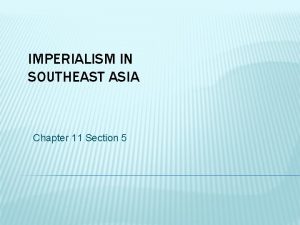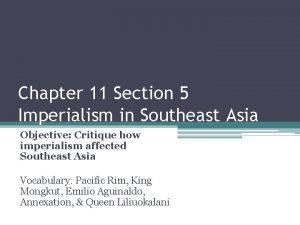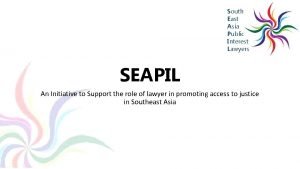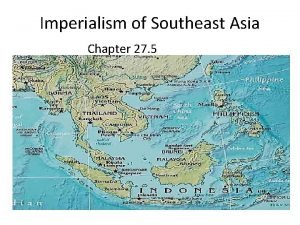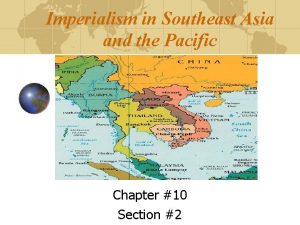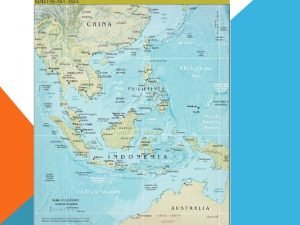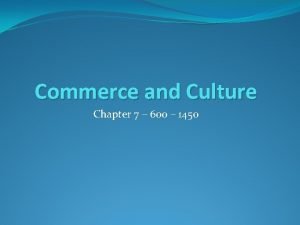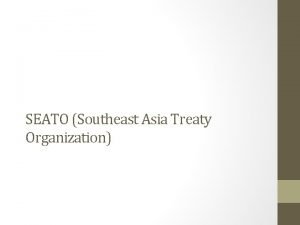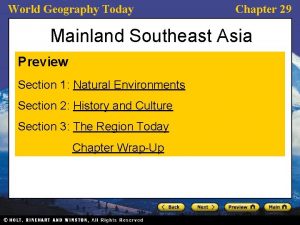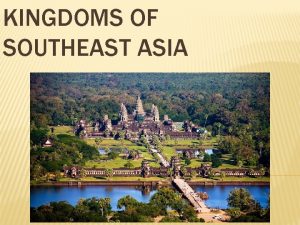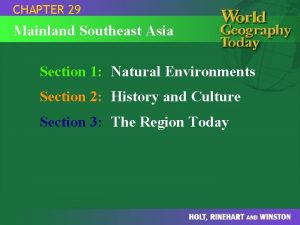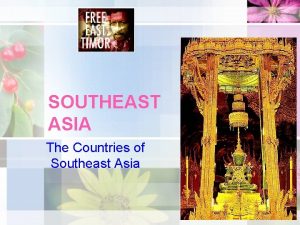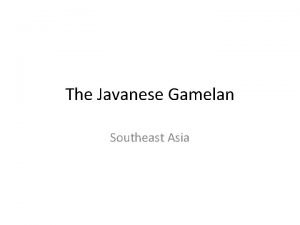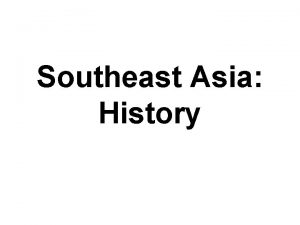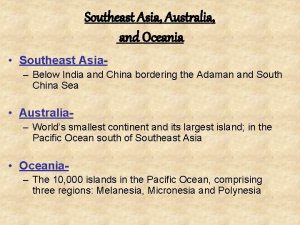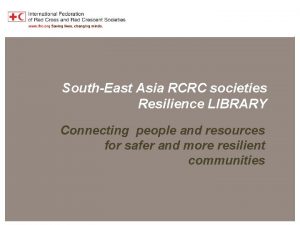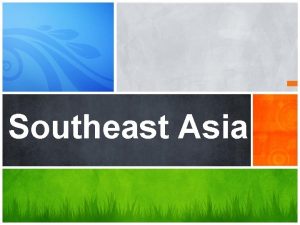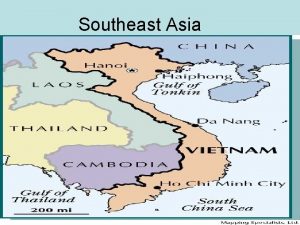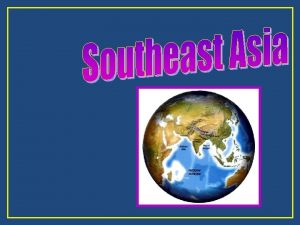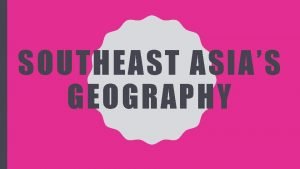Cultural Geography of Southeast Asia Mainland Southeast Asia

















- Slides: 17

Cultural Geography of Southeast Asia

Mainland Southeast Asia Influenced by India, Chinese, Islamic, European and American cultures over 2, 500 of years 520 million people live in region 2, 500 years ago groups from China moved into region Khmers- Cambodia, Vietnam Mons- Myanmar Malays- Malay Peninsula and Indonesia Developed agricultural civilizations

Mainland SE Asia Population densities vary across region Laos lowest population density Vietnam highest Population concentrated along fertile coastal plain Ready supply of water, transportation, fertile land Many moving to cities for economic opportunity

Mainland Southeast Asia Cities For centuries majority lived in rural villages Many today moving to urban areas Cities provide greater opportunities and access 11 cities of more than 1 million Some countries have primate city, economic center, major port, often the capital Bangkok- 650% growth over 50 year period (1950 -1998) Public services not adequate, government trying offer incentives to have industry and cities return to rural areas

Outward Migration Since 1970’s because of political and economic troubles many SE Asians left region US has large numbers of immigrants from the region Causes countries to lose skilled labor force needed for economic growth

Mainland SE Asia Early Civilizations- agricultural, based on rice production, domesticated cattle and pigs Funan- first empire in SE Asia, adopted Hinduism, Indian model of centralized government Khmer Empire- surplus agriculture brought wealth to mainland 1100’s-1200’s Khmer Empire, based in present day Cambodia Advanced irrigation and agriculture allowed them to feed huge population and diversify society Angkor Wat architectural achievement, designed to resemble home of Hindu gods

Mainland SE Asia Srivijaya Empire- based on island of Sumatra Maritime empire controlled trade in the region 600 -1300 Used navy to control Straits of Malacca Vietnam- struggled against Chinese China conquered region 111 B. C. Introduced ideas about religion, government and philosophy

Mainland SE Asia Western Colonization- 1500’s Europeans begin to control trade Siam (Thailand) was a buffer state separating British and French controlled areas, only southeast Asian area to remain free from European control Europeans brought change to region Built roads, railroads, improved harbors, expanded mining, established commercial plantations All profits went to westerners Increased tension and conflict in region Asians received low wages Plantation owners imported workers to meet growing demand for goods, contributed to ethnic diversity of region

Mainland SE Asia Post WWII- after war countries struggle to regain control of region, SE Asians wanted independence, after two decades all countries were independent of European powers Communism divided Vietnam, Laos, Cambodia Vietnam- US unsuccessfully intervened in the 1960’s and 1970’s to stop spread of communism Ethnic conflicts across region have resulted in militant terrorist groups emerging (many anti- western) Some countries have recently moved toward democracy, some are still communist (Laos, Vietnam), Myanmar is a military dictatorship

Cambodia: Population Decline Since 1970’s population growth slow in Cambodia 1975 -1979 lost 38% of population due to harsh rule by Khmer Rouge communist government Forced people out of cities to countryside to become farmers More than 1 million died Starvation, torture, execution of people considered intellectuals (doctors, teachers)

Mainland SE Asia Cultures in region reflect ethnic diversity China and India shaped much of the cultural development of the region Since 1945 literacy has increased in parts of region where there are resources Health care is inadequate in many countries, mostly in rural areas Many different languages spoken Come from 2 major language families- Sino-Tibetan, Mon-Khmer Many languages reflect colonial power French (Vietnam) All major religions of the world are represented Buddhism is the predominant religion

Island SE Asia Includes Indonesia, Malaysia, Singapore, Brunei, East Timor, Philippines Spices attracted outsiders to region Merchants from India came for spices and introduced Hinduism and Buddhism Chinese influenced cultures of Brunei and Singapore where more than 70% of population has Chinese ancestry Around 800 A. D. Arab traders came and introduced Islam 1500’s Europeans arrive to take advantage of trade and natural resources

Island SE Asia People live mostly along coastal plain, mountainous interiors are sparsely populated Population growing faster than global average Some islands have high population densities Java has over 2, 300 people per square mile Singapore is the most densely populated country People migrate to cities for economic and educational opportunities Jakarta has over 10 million people, the government is trying to reduce overcrowding by relocating population to smaller islands

Island SE Asia History of region is connected to control of trade routes Different empires have profited from control of Straits of Malacca Today Singapore owes its prosperity to these same trade routes Europeans brought physical improvements After WWII many countries won their independence from European powers 2002 East Timor, a Catholic country gained its independence from largely Muslim Indonesia 1998 Indonesia moved toward democracy after years of a dictatorship Philippines, East Timor and Singapore are democracies Brunei and Malaysia are constitutional monarchies

Island SE Asia Since independence education and health care and quality of life have improved Literacy rates are high Health care is better than mainland SE Asia Indonesia has government sponsored health care and Singapore has health care as good as developed countries Indonesia has over 300 ethnic groups and 250 distinct languages, makes it hard to unify country Other regional languages reflect colonialism; Philippines, Malaysia (English), Islam is wide spread across the region, Indonesia is the largest Islamic country in the world The Philippines are mostly Roman Catholic


Island SE Asia Architecture- religious structures influenced by religion Borobudur Temple. Indonesia, built of volcanic stone, stages of shrines represent Buddha's journey to enlightenment Catholic Churches built by Spanish Mosques found in Muslim countries
 Mainland of southeast asia
Mainland of southeast asia In 1500 mainland southeast asia was a relatively
In 1500 mainland southeast asia was a relatively Chapter 15 lesson 1 physical geography of north africa
Chapter 15 lesson 1 physical geography of north africa Reteaching activity 24 cultural geography of south asia
Reteaching activity 24 cultural geography of south asia Metapopulation
Metapopulation Fraser valley health region map
Fraser valley health region map Chapter 11 section 5 imperialism in southeast asia
Chapter 11 section 5 imperialism in southeast asia Southeast asia 1450 to 1750
Southeast asia 1450 to 1750 Chapter 27 section 5 imperialism in southeast asia
Chapter 27 section 5 imperialism in southeast asia East asia spice t chart
East asia spice t chart Imperialism in southeast asia chapter 27 section 5
Imperialism in southeast asia chapter 27 section 5 Seapil
Seapil Urban realms model
Urban realms model Imperialism in southeast asia chapter 27 section 5
Imperialism in southeast asia chapter 27 section 5 Imperialism in southeast asia and the pacific
Imperialism in southeast asia and the pacific Climate regions in east asia
Climate regions in east asia Weaving the web of an indian ocean world
Weaving the web of an indian ocean world Ramon magsaysay seato
Ramon magsaysay seato

